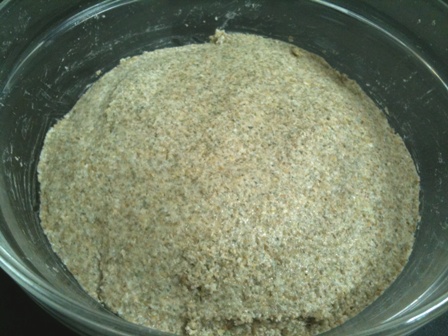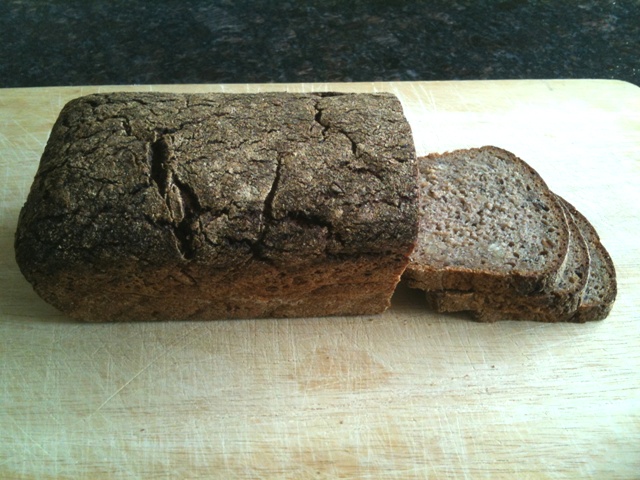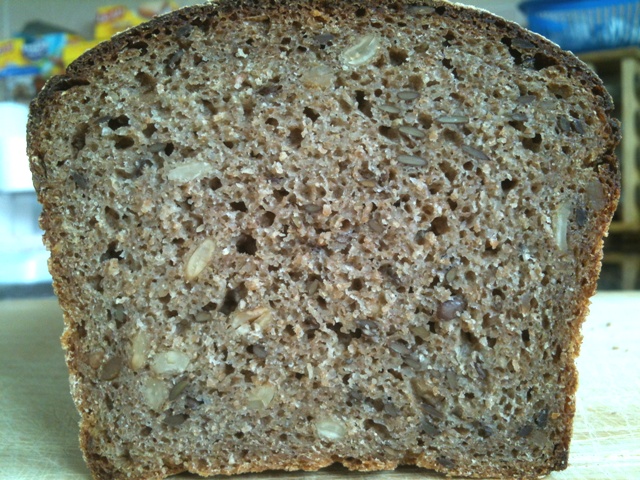I’ve always wanted to bake a Volkornbrot, and Peter Reinhart’s Version in “Wholegrain Breads” was appealing enough, though challenging too. The Recipe involves a soaker and a biga, as usual. However, the Biga was in the form of a Stiff Rye Sourdough, and the soaker was a Mash/scald. I have elected to skip the called for yeast, and went by the baking instruction of Hamelman’s version of volkornbrot in “Bread”.

MASH / SCALD:
120 g Whole Rye Meal
300g Water
3T Flaxseeds
½ tsp Malted Flour
Procedure:
- Preheat oven to 200F (93C)
- Add all ingredients except flaxseeds to a 165F (74C) water, stir, cover and insert into the oven. Reduce temperature immediately to 150F (66C). Leave the mixture in for 1-3 hours at 66C.
- When done, remove the mixture, and taste it. It should quite sweet. Add the flaxseeds, stir, and cover. The Mash can be used within 24 hours at room temperature, or up to 3 days in the refrigerator. (Note: On baking day, remove the Mash from the fridge 2 hours early to de-chill)

SOURDOUGH
213g Whole Rye Meal
170g Water
71g (1/3cup) Mature Sourdough Culture
Procedure:
- Mix all ingredients well, cover and let ferment at room temperature from 6-8 hours until the mixture is well ripe. Degas it by stirring it, cover then refrigerate for up to 3 days.(Note: On baking day, remove the Mash from the fridge 2 hours early to de-chill)

FINAL DOUGH
454g Sourdough
425g Mash / Scald
255g Whole Rye Flour
50g Water
42.5g lightly toasted Sunflower Seeds
1 ¼ tsp Salt
Procedure:
- Mix All Ingredients together to a thick sticky paste. If the consistency isn’t so, add water/flour as needed. Oil a bowl, and insert the paste into it. Cover and let ferment at room temperature for 10-20 minutes. Scrape the paste onto a floured surface (Rye flour), and work the paste into a log shape, incorporating as little Rye flour as possible. Insert the log into an oiled + Rye Floured pan, cover and let ferment for 45-60 minutes at 82F.
- ½ hour prior to the bake, preheat your oven to 460F and prepare your steaming method. 5 minutes, before the bake time, insert the steaming device. Finally, insert the pan carfully into the oven, as dough is fragile at this stage, and turn down the oven to 370F. Bake 10minutes under steam, and 45 without. During the last 15 minutes, remove the loaf from the pan, and bake bare until it brows evenly.
- Remove the loaf and immediately wrap in a kitchen towel for 24-48 hours prior to slicing.


The aroma of the baked Volkornbrot was as expected, fragrant, and sweet. 24 hours after the bake, the crust was chewy, and the crumb was moist and tender, and speckled with toasted nuts, and seeds. The Typical earthy Rye sweetness lingers in your mouth minutes after you swallow, with a pronounced sour note.
The Mash has created a very manageable dough, unlike most Rye bread without mash/scald. Flavor-wise, the mash did add up to the subtle sweetness of the crumb.
Recommended!